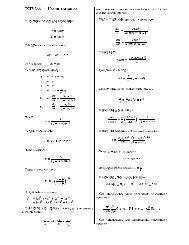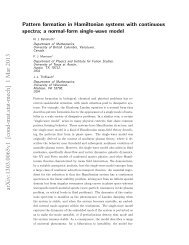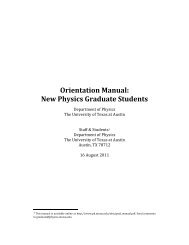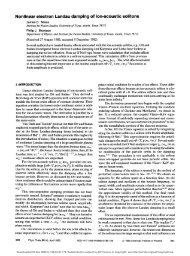Magnetic Fields and Magnetic Diagnostics for Tokamak Plasmas
Magnetic Fields and Magnetic Diagnostics for Tokamak Plasmas
Magnetic Fields and Magnetic Diagnostics for Tokamak Plasmas
You also want an ePaper? Increase the reach of your titles
YUMPU automatically turns print PDFs into web optimized ePapers that Google loves.
<strong>Magnetic</strong> fields <strong>and</strong> tokamak plasmas<br />
β I<br />
= 2µ p ( 0)<br />
0 0<br />
2<br />
( 1+ γ )B θ 0<br />
( 1)<br />
Alan Wootton<br />
6.42<br />
Now we can use the normalization x = r/a in equation 6.26 to obtain an expression <strong>for</strong> the surface<br />
displacement:<br />
d∆ 1<br />
dx = − εa<br />
2<br />
⎡<br />
β I<br />
( γ +1)x 2 1− x 2<br />
⎢<br />
⎣<br />
2x<br />
( 1 −( 1− x 2<br />
) 1+ α<br />
) 2<br />
x<br />
( ) − ( 1 − ( 1 − x 2<br />
) 1+α<br />
) 2 dx<br />
∫<br />
( ) γ − β I<br />
1 − ( 1 − x 2<br />
) γ +1<br />
0<br />
x<br />
⎤<br />
⎥<br />
⎦<br />
6.43<br />
Where ε = a/R g . The Shafranov Shift is defined as the distance between the magnetic <strong>and</strong><br />
geometric axis: ∆ s = ∆ 1 (1). Using a power series expansion <strong>for</strong> ∆ 1 (x) up to terms x 6 a general<br />
expression can be derived:<br />
∆ s<br />
= εa<br />
2<br />
⎡<br />
1 + 2α 9 + α 2<br />
⎢ 72<br />
+<br />
⎢ 4<br />
⎢ β I<br />
γ ( γ +1)<br />
⎧<br />
2 + 11α<br />
4( 1 + α) 2 9 + 5α 2<br />
⎨<br />
18 + γ − 1<br />
⎣ ⎢ ⎩<br />
6<br />
( )( γ − 6)<br />
⎤<br />
⎥<br />
⎥<br />
4α γ −1<br />
− ( ) ⎫ ⎥<br />
⎬<br />
9 ⎭ ⎦ ⎥<br />
6.44<br />
For the simple case of a flat current profile (α = 0, l i = 0.5) <strong>and</strong> a parabolic pressure profile (γ =<br />
1) we obtain<br />
∆ s<br />
= εa ⎛<br />
2 β + l i ⎞<br />
⎝<br />
I<br />
2⎠<br />
6.45<br />
Matching vacuum <strong>and</strong> plasma solutions<br />
Returning to the field outside the plasma, we must match the vacuum field to the solution <strong>for</strong><br />
B θ (a). The vacuum field is given by the solution to (∇xB) φ = 0. Expressing B R <strong>and</strong> B z in terms<br />
of ψ (Equations 6.2 <strong>and</strong> 6.3), (∇xB) φ has the <strong>for</strong>m of the LHS of Equation 6.18. This has a<br />
solution of the <strong>for</strong>m (<strong>for</strong> r
















